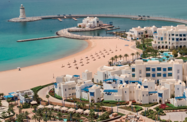As the country’s hosting of several major international sports and business events has brought growing numbers of tourists to Qatar, it has also highlighted the need for infrastructure to accommodate them.
Tourist arrivals from the other GCC member states rose by 22% year-on-year (y-o-y) in the first quarter of 2012, the Qatar Tourism Authority (QTA) announced in May. This followed a 50% increase in 2011, when more than 845,000 visitors from the region came to the country.
Visitor numbers from other areas are up as well: though the QTA did not release overall tourist numbers, it said that arrivals from Europe were up 15% y-o-y, tourists from the Arab world increased by 19% y-o-y, and visitors from the rest of Asia were up by 58% y-o-y.
Business travellers make up the majority of visitors, accounting for 72% of all arrivals. Qatar attracts business tourists for several reasons: its own thriving economy, one of the fastest-growing in the world in recent years; its position as a base for business (and international organisations) across the Middle East; and its growing status as a destination for meetings, incentives, conferences and exhibitions (MICE).
The MICE segment in particular has benefitted from Qatar’s geographical location, international connectivity, and a growing range of venues. The country’s new flagship space is the Qatar National Convention Centre (QNCC), opened in December last year, with an exhibition area of 40,000 sq metres and a capacity of 10,000 visitors. The QNCC complements the existing Doha Exhibition Centre, a 15,000-sq-metre complex that hosted the biannual Doha Trade Fair, the country’s largest trade festival, from July 1 to July 10. The event was expected to attract 200,000 visitors and exhibitors from more than 30 countries.
After business tourism, Qatar is perhaps best known as a destination for international sports events, particularly after it won the right to host the FIFA 2022 World Cup. The country has already hosted tournaments including the 2011 AFC Asian Cup finals, the 2011 Arab Games, the 15th Asian Games in 2006 and the annual Qatar Open, as well as MotoGP and golf events.
According to Saoud bin Abdulrahman Al Thani, the general secretary of the Qatar Olympic Committee, the country is also planning to bid to host the 2024 Summer Olympic Games, international press reported in late June. The state would continue to bid for the games despite having been turned down for the 2016 and 2020 events, Al Thani said.
The World Cup tournament is expected to attract 500,000 visitors to the state over just a few weeks, a substantial fillip for the sector, as well as a major infrastructural challenge. Projects valued at between $80bn and $100bn are in the pipeline or under construction, including an inter-city rail network, a metro system, the Doha New Port Project and the Doha New International Airport.
The influx of visitors will also require a considerable expansion in hotel capacity, which is already under way. The country aims to have more than 90,000 hotel rooms by 2022. With the opening of eight new hotels in 2011, existing capacity almost doubled to 11,341 rooms, from 5974 in 2010. Occupancy rates were 64% in first-quarter 2012, down from 68% in 2011, according to the QTA.
Much of the development so far has been in the luxury end of the market, with recent developments including a Mandarin Oriental Hotel, Shangri-La Hotel, St Regis Hotel and a second InterContinental. In fact, revenues of four- and five-star establishments reached QR734m ($201.6m) in first-quarter 2012, a QR32m ($8.8m) increase from the same period last year, the QTA reported.
The QTA has already given approval for the construction of 100 more hotels, Abdulla Malalla Al Bader, the director of tourism at the QTA, told local media in June. He added that the authority has worked with the Qatar Development Bank to allow investors of any nationality to receive loans for tourism development.
As more rooms are built, however, hotels may be faced with lower revenues and occupancy rates, at least in the short term, as the current influx of visitors will likely not be able to fill all the new available capacity. Of equal concern, particularly in Doha, is a belief that the city still has some way to go in developing an urban space that combines this new infrastructure and the city’s core identity.
While business visitors continue to remain at the heart of Qatar’s tourism sector, the sports segment is slowly establishing itself on the global stage. Building up the infrastructure necessary to accommodate these diversification efforts will go a long way to supporting the sector’s long-term future.

